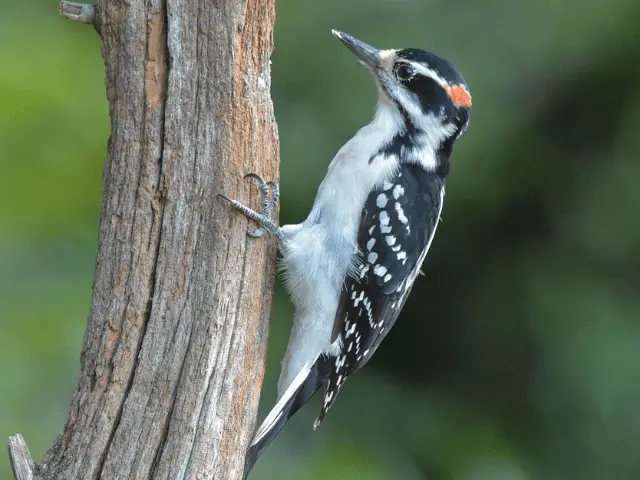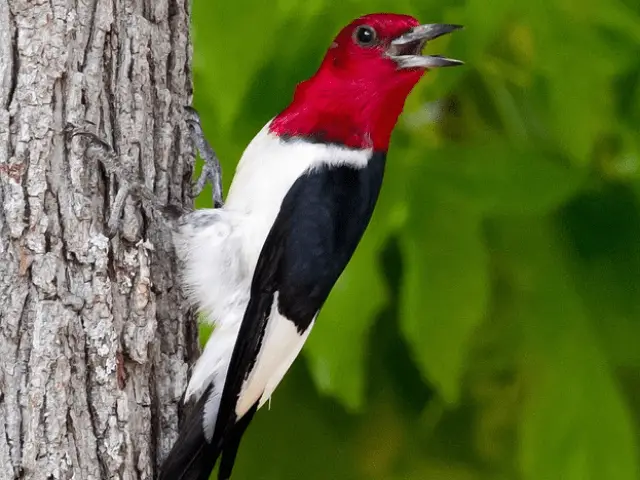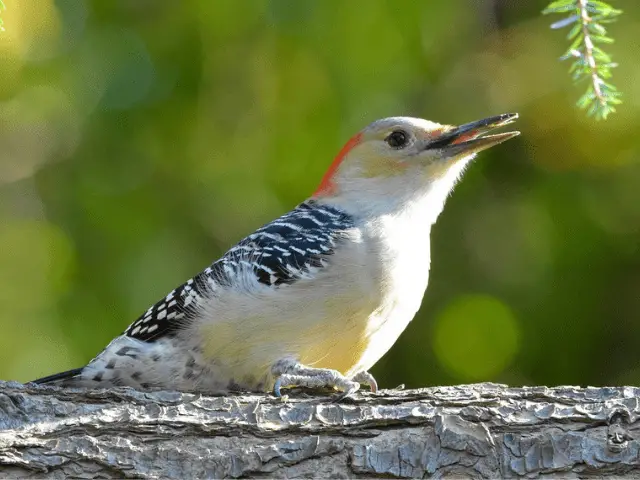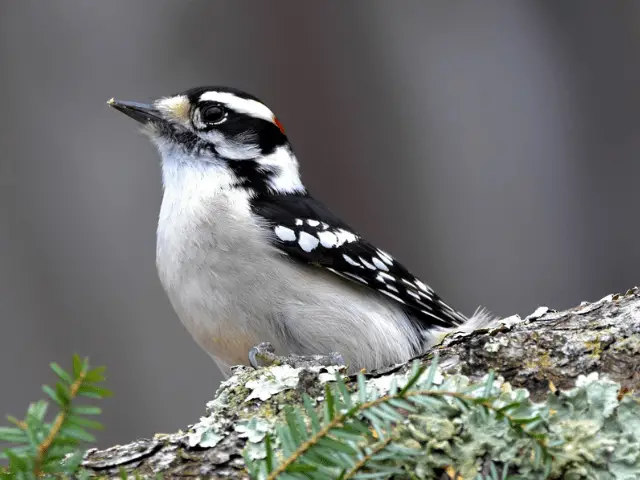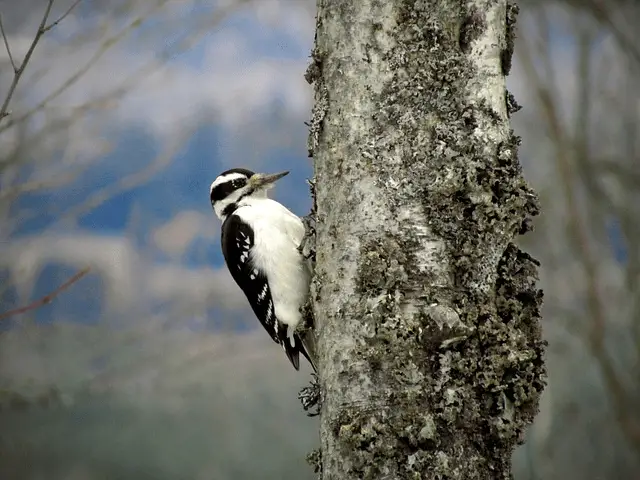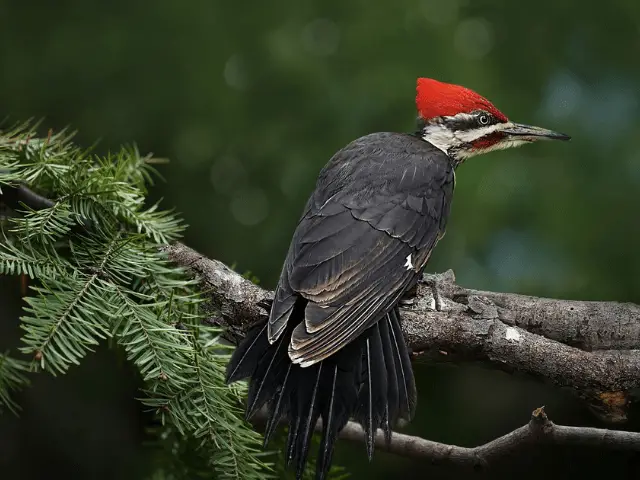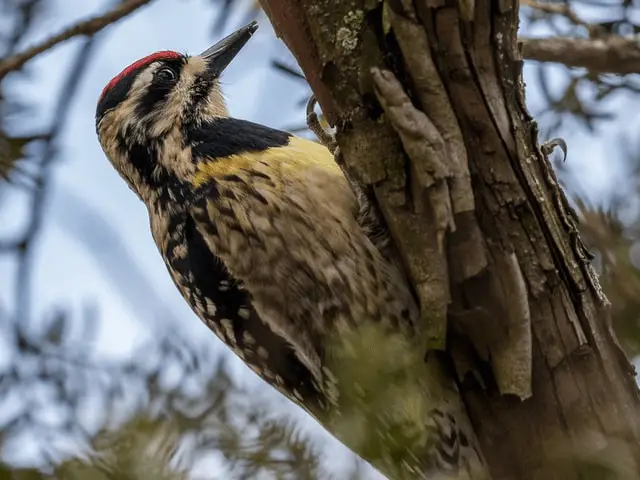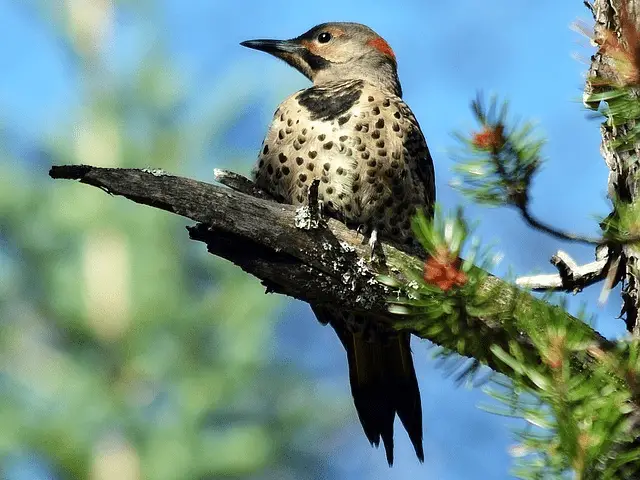Many bird-watching enthusiasts are all too familiar with the daily lives of woodpeckers. You have likely seen a few woodpeckers circling your neighborhood at some point.
True, right?
If you are interested in learning more about these beautiful creatures, this guide will tell you all about the woodpeckers in Indiana.
The Nature Of Indiana Woodpeckers
While you can find a total of 22 throughout the United States of America, there are only seven types of woodpeckers in Indiana. These curious birds roam many urban areas and arboraceous lands in the state.
Indiana woodpeckers are a peaceful bunch of birds. With their feeders filled with snacks and water, many natives of the state welcome these woodpeckers to their yards.
Although it takes time to gain the trust of these shy birds, you could be bonding with a new feathery friend if you have enough patience.
The following section will highlight all the defining traits of these Indiana birds.
1. Red-Headed Woodpecker
Measurements
- Wingspan: 16 inches
- Weight: 2 - 3 ounces
- Length: 7 - 9 inches
Appearance
Red-headed woodpeckers are generally average-sized woodpeckers. They have heads that elegantly sit atop their rounded shoulders and delicate, broad wings.
As you might have guessed, red-headed woodpeckers have vibrant red-colored heads, which make them easy to identify. You can also quickly recognize their snow-white underparts and black wings with white midsections.
Young red-headed woodpeckers tend to have brownish heads but retain their wing spots and short tails into adulthood.
Temperament
Like many woodpeckers of Indiana, red-headed woodpeckers use their strong beaks to drill into the wood for insects. These agile birds can even catch insects during the flight if necessary, and it doesn’t stop there.
Red-headed woodpeckers stalk the ground to look for all sorts of tasty insects and grubs.
Despite having an appetite for insects, these woodpeckers also eat various kinds of fruit and seeds in their environment.
If their red-colored heads don’t give it away, you can always identify the red-headed woodpecker’s shrill and rough calls.
Habitat
You can most commonly see red-headed woodpeckers settling in clear, open forests as well as pine savannas. From countrysides to pine plantations, these woodpeckers quickly adapt to damp and vast environments.
2. Red-Bellied Woodpecker
Measurements
- Wingspan: 13 - 16 inches
- Weight: 2 - 3 ounces
- Length: 9 inches
Appearance
Red-bellied woodpeckers have polished, firm builds and rounded heads. They are medium-sized birds with subtle, compact figures; their long, firm beaks are a tree’s worst enemy.
Just like their name implies, red-bellied woodpeckers have prominently reddish, pale underparts. They have a bright red-orange streak that trails along their foreheads and necks. These woodpeckers also feature a zebra-like pattern of black and white on their wings and tails.
Temperament
Red-bellied woodpeckers frequently hitch onto trees and branches with their sharp talons. Despite being a woodpecker, the red-bellied woodpecker plucks tree bark with its beaks instead of pecking it.
You might also spot these birds awkwardly flying in different directions. Red-bellied woodpeckers do this to track a sudden cluster of calls.
Habitat
Red-bellied woodpeckers are one of the several woodpeckers of Indiana that stay year-round. These woodpeckers thrive in fairly tall heights along sturdy branches in dense forests and woodlands. Some are also curious enough to visit feeders throughout the state.
3. Downy Woodpecker
Measurements
- Wingspan: 9 - 12 inches
- Weight: 0.7 - 1 ounces
- Length 5 - 7 inches
Appearance
Downy woodpeckers belong to the smaller group of woodpeckers in Indiana. These delicate birds have slim bodies and short beaks. Downy woodpeckers carry themselves in an upright posture on tree limbs with their broad shoulders and proportionate heads.
With its streaky and checkered patterns, the downy woodpecker is impossible to miss. Although their underparts are primarily white, these woodpeckers feature black tails and black-and-white backs.
Downy woodpeckers have vivid black wings with small white spots. Males of the species have a distinct patch of red on their crowns.
Temperament
Being a small woodpecker, downy woodpeckers can quickly hitch around tree trunks to dive into tall weeds. Their tiny, compact build enables them to perform agile movements from elevated heights.
Habitat
Downy woodpeckers can survive in densely populated areas, open parks, and even woodlots. However, you can also spot these Indiana woodpeckers staying in wild woodlands among deciduous trees and weedy edges. The downy woodpecker even visits vacant lots and backyards across Indiana.
4. Hairy Woodpecker
Measurements
- Wingspan: 13 - 16 inches
- Weight: 1 - 3 ounces
- Length: 7 - 10 inches
Appearance
Hairy woodpeckers are decently-sized woodpeckers with well-rounded heads. These woodpeckers have extended, pointy beaks that complement their broad chests. Their long tail makes it easy for them to balance on the sides of the trees.
You can also identify their checkered black and white wings similar to those of a downy woodpecker’s. A small streak of white trails along their broad backs is visible during flight. Other than that, hairy woodpeckers have shiny white underparts.
Male hairy woodpeckers have a medium-sized red patch at the back of their heads.
Temperament
Hairy woodpeckers love to stay high up in trees and large branches. They even spend some of their time lurking around tree bases and logs for insects and seeds.
These woodpeckers perch with a soldier-like, erect posture that makes them easy to spot.
Habitat
If you want to take pictures of woodpeckers in Indiana, the hairy woodpecker is the ideal species. Birders can find these creatures in various mature forests across Indiana and near suburban areas, parks, and cemeteries.
5. Pileated Woodpecker
Measurements
- Wingspan: 26 - 30 inches
- Weight 8 - 12 ounces
- Length: 16 - 19 inches
Appearance
When it comes to size, the pileated woodpecker sits at the top. Pileated woodpeckers are the largest woodpecker species in the United States of America.
The pileated woodpecker’s most noticeable feature is their flaming red, mohawk-like crest atop their heads. These enormous birds are primarily black throughout their bodies. However, you can see streaks of white on their necks, faces.
Bird watchers can immediately spot the pileated woodpecker’s white upper half on their underwings when extended.
Temperament
Pileated woodpeckers characteristically create rectangular-shaped holes along the sides of old, rotten wood to find carpenter ants. In some cases, this process causes a tree to break in half cleanly.
Habitat
Pileated woodpeckers commonly settle around old forests with rotten and broken trees. On the other hand, these large woodpeckers also thrive in deciduous and evergreen forests. They also frequently visit backyard feeders and residential areas.
6. Yellow-Bellied Sapsucker
Measurements
- Wingspan: 13 - 16 inches
- Weight: 1 - 2 ounces
- Length: 7 - 9 inches
Appearance
Yellow-bellied sapsuckers are moderately small woodpeckers with plump beaks. Their large wings only extend halfway during the flight but fold neatly onto their spiky tails.
The yellow-bellied sapsucker boasts its rather exquisite appearance of black-and-white striped patterns. While males highlight bright red necks, both sexes have a signature red forehead and lined faces.
They have black-and-white wavy patterns across their wings with a distinct long, white streak along with their wingtips. Yellow-bellied sapsuckers also have yellowish underparts that look white under specific lighting.
Temperament
Yellow-bellied sapsuckers naturally harvest sap from trees. These birds can make deep holes into trees without making the opening too wide.
The yellow-bellied sapsucker produces a distinct drumming sound when they create sap wells into trees. You can also notice their undulating flight patterns.
Habitat
You can find yellow-bellied sapsuckers in many new deciduous forests in Indiana. These organized birds tend to drill rows of sap wells that you can quickly identify. Otherwise, yellow-sapsuckers settle in groves filled with aspen trees and vast woodlands.
7. Northern Flicker
Measurements
- Wingspan: 16 - 20 inches
- Weight: 3 - 6 ounces
- Length: 11 - 12 inches
Appearance
Northern flickers are pretty exotic and large birds. They have rounded heads to match their curved bills. A long, pointed tail also neatly sits at their backs.
The northern flicker has an assortment of colors throughout its body. Although these woodpeckers are primarily gray and brown, you can also observe their white rumps visibly when they settle on trees.
They have large, brown wings with black markings until their wingtips. Northern flickers feature bright yellow underwings and tails. You can swiftly recognize their dotted underparts as well as a patch of black on their chests.
Temperament
While they love hitching up trees and hammering into the wood, northern flickers also find joy in searching for food on the ground. These beautiful woodpeckers often dig in the dirt to find ants to eat.
Habitat
Among woodpeckers in Northern Indiana, northern flickers stay in yards, parks, and plenty of woodlands in Indiana. If you can't seem to find them on trees, then you might see them digging away at some ants on the ground.
Frequently Asked Questions
What kind of woodpeckers are in Indiana?
As discussed above, Indiana is the beautiful home to 7 woodpecker species. These are the following:
- Red-headed woodpecker
- Red-bellied woodpecker
- Downy Woodpecker
- Hairy woodpecker
- Pileated woodpecker
- Yellow-bellied Woodpecker
- Northern Flicker
Here's an interesting video of how a pileated woodpecker carves out a hole in a tree:
Can you shoot woodpeckers in Indiana?
The Federal Migratory Bird Treaty Act indicates regardless of which state you're in, it is illegal to kill woodpeckers without a special permit.
Final Thoughts
Everyone can become a bird expert, and for the woodpeckers in Indiana, understanding these birds are definitely worth the time. Seven species may not seem like a lot, but you would be surprised to discover the plentiful unique characteristics of Indiana woodpeckers.
With their peaceful and friendly behaviors, you can admire these woodpeckers in their habitats or even your backyard.
